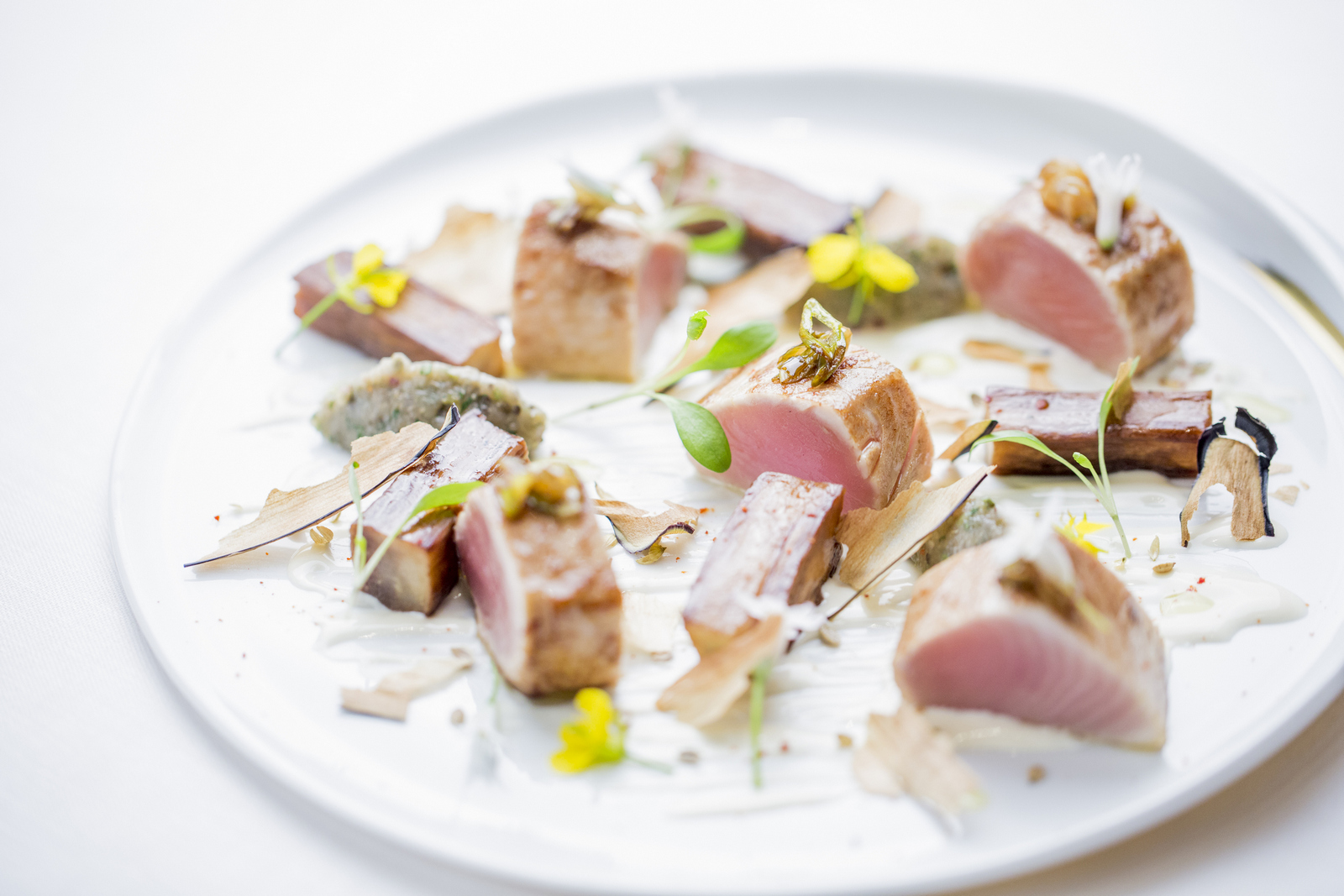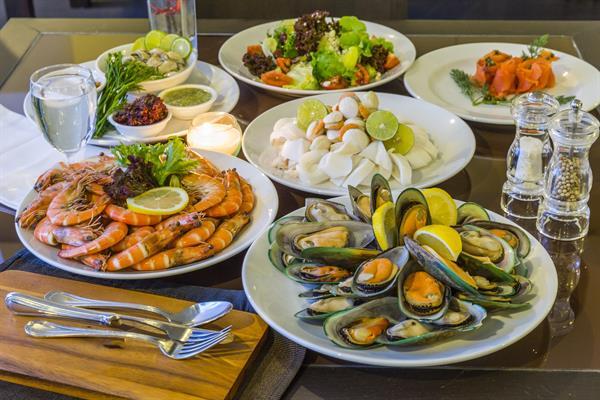Le Meurice Alain Ducasse
For the gourmet restaurant at the Hôtel Le Meurice, the multi-Michelin-starred chef is crafting a menu that celebrates his culinary philosophy, guided by the watchwords of excellence, elegance and experience.
The chef takes care to preserve the authentic flavours of exceptional ingredients and transport them from the kitchen to the table. Each dish expresses the truth of its ingredients. The yellow, purple and orange carrots, artichokes and Chioggia beetroots in the vegetable casserole come from Créance in Normandy, where they were strictly organically grown. The caviar, made from the eggs of Schrencki sturgeons sourced from China’s Amur River, is served with the bonito and has a beautiful amber tint that bewitches the eye before its mellow, silky taste enchants the palate.
For the diner to experience true pleasure, the technical intervention of the chef must be unnoticeable. Yet, with Jocelyn Herland and his staff, technical mastery is very present! It is found in traditional nods to French Haute Cuisine, for example, with the guinea fowl pie in a delicate short crust. Or in the savvily mastered complexity of the bonito fillet that is first very lightly seared for consistency, then smoked with birch wood before being marinated for twenty-four hours in a seasoned jus. Nevertheless the diner will know nothing of this extensive process: elegance is only ensured when the technique modestly fades into the background.
For Alain Ducasse, “A successful meal is an unforgettable moment of happiness.” It means contrast on the palate that renders every mouthful truly memorable. These surprises start with the amuse-bouche in the form of a quail egg: the egg is poached, rolled in a blend of lime peel and grated horseradish, then arranged in a thin buckwheat crêpe and topped with an exquisite caviar quenelle.
The same perfectly mastered, yet unexpected tastes are found in the meat. The salmis sauce and turnip-horseradish condiment served with the pigeon en crapaudine add delightful vigour. More astounding still: the veal medallion, a down-to-earth dish if ever there was one, is larded with marinated anchovies and served with a fresh seaweed infusion and an oyster condiment that are redolent of the sea.
La cuisine de l’essentiel remains ever faithful to the truth of the ingredient and honest, interpretable dishes. But freely reinterpreted to provide new impetus, gain new momentum.
The essential expressed in pastry, for Executive Pastry Chef Cédric Grolet, means shaking off the excess sugar and fat that suffocates flavour – furthermore the appetite! But also limiting the number of ingredients to make tastes lighter and more easily recognised.
The wine menu is designed, first and foremost, to bring the taste of a terroir into the glass. With expert guidance from Gérard Margeon, Executive Head Sommelier for the Alain Ducasse restaurants, and Damien Azemar, the restaurant’s Head Sommelier, the great French classics courteously share the cellar with the finest oenological discoveries of the moment.
Lastly, the essential must be incarnated in the service having a profound understanding of hospitality, spiced by today’s rhytmn and energy. Frédéric Rouen, the Restaurant Manager, ads, “What is the most difficult after all is doing things simply, with just the right gesture and appropriate word.”
La Cuisine de l’Essentiel championed by Alain Ducasse seeks to express the truth of the ingredient in honest, interpretable dishes, which does not, however, exclude revisiting the repertoire to translate the energy of the era. Philippe Starck has made this possible through his choice of new decorative elements. To the splendour of the Versailles-inspired dining room he adds modern touches that underscore its magic. Dispensing with aesthetic duplicity, he sweeps away the solemn sacredness that restricts true pleasure. The red carpet at the dining room’s entrance paves the way to a moment that must be joyous to be memorable: it is bedecked with humorous aphorisms drawn from the Code Gourmand written in 1828 by Horace Raisson. This spiritual nod plays off the design of the two screens set at each end of the room. Described as precursors to an exquisite corpse, they provide a framework for messages, photos, sketches, and more, all tributes to the art of conversation and imagination. Philippe Starck creates a stimulating dialogue between styles.
The archetypal Louis XV chair is replaced by the iconic Eero Saarinen Tulip chair. The ceiling’s fresco inspired by the 18th century fits in harmony with the custom-made carpet. A scallop-shaped basin hosts an original sculpture by Murano artist Aristide Najean capturing the suspended movement of water. Nonetheless the foundation of Starck’s impact is almost imperceptible. It is found in the atmosphere of the dining room. The rosy copper used on various furnishings creates a singular atmosphere. It unfolds and undulates in sleek, gleaming lines, reducing objects to their functions. The final element in this striking staging is the light and its relationship to the materials around it. Bouncing off the copper, it is diffracted by the crystals in the imposing chandeliers, filtered, by day, through the blinds on the large windows and softened in the evening by the warm wall lights, glinting from the hanging polymer droplet of each. Here, the essential is the very essence of the space, as well as the soul of the cuisine of Alain Ducasse.
Le Dalí is a unique place, one in which a singular, elegant and relaxed spirit reigns supreme. A very Parisian place to be seen, as well as a cosy, welcoming hideaway. Philippe Starck already left his mark here in 2007 and has now initiated a second aesthetic exploration. As if to answer Dalí himself, who said “ my entire life is determined by two conflicting ideas: the top and the bottom ”, the designer plunges into the space’s depths, both vertically and horizontally. The new carpet designed by his daughter Ara echoes her immense earlier canvas stretched across the ceiling. Both works distort reality: the ceiling soars and the ground sinks into the winding ways of a crypt, like the convolutions of the brain. At the back of the room, a huge, slightly tilted mirror creates an unexpected escape from the public gaze. The lighting on the sixteen columns surrounding the space introduces a vertical luminescence that stretches the room. Crafted of copper and topped with lampshades in light-coloured natural silk, they all boast a large polymer droplet that captures the light. This verticality is answered by the horizontal glow of the tables. Their fine Arabescato white greyish marble tops are backlit generating a glowing magic. Displayed throughout the space, they offer islets of light and privacy echoing the service table, “the table of the four seasons”, which is backlit, as well. Through a few carefully scattered hints, Philippe Starck also builds an aesthetic bridge between Le Dalí and the surrounding spaces. The pink copper element in the centre of the room acts as a symbolic mirror, a nod to the neighbouring gourmet restaurant in which this material is extensively used. Likewise, the distressed brass encircling the “table of the four seasons” presages the mirrors of the Galerie Pompadour. The designer also took care to preserve the subtle ties with the spirit of Salvador Dalí that permeates the place: the Swan chair and the rocking chair, for example, are still there. But classics also merit reinvention: Philippe Starck has designed chairs covered with canvas drawings by Ara Starck.
For the reopening of Le Dalí, Alain Ducasse creates a dialogue between the traditional Parisian brasserie and the Mediterranean cuisine. Under the talented direction of Executive Chef Jocelyn Herland, the new menu is a celebration of the Ducasse vision of contemporary cuisine – sincere, flavourful and made to share – with dishes designed to be enjoyed with others, or served in half-portions for light aperitif eating.
For many years, from the French Riviera to the Catalan coastline, from Liguria to the shores of North Africa, the multi-Michelin-starred chef has made Mediterranean culinary culture his mental terroir. Indeed, at Le Dalí, there is no shortage of Mediterranean flavour. Giving credit where credit is due, the journey upon which guests embark begins with the Catalan lands of Salvador Dalí, with specialties such as stuffed pimiento del piquillo with romesco sauce or black rice, baby squid and shellfish. The voyage then continues in Italy through some of that country’s finest foods, like black pork culatello from Massimo Spigaroli, straight from EmiliaRomagna. But also home-style cooking – slowsimmered and colourful – like aubergine caviar, a Provence-style vegetable caponata or minestrone broth and vegetables with garlic-basil condiment. Guests can also sample patatas bravas with an authentic tasca taste and enjoy down-to-earth specialties like salt cod, aioli and coco beans sourced from Valence up to the County of Nice, served here with Catalan accents. Mediterranean cuisine can also be delicate and sophisticated, as in this seared gilthead bream, violin courgette and stuffed zucchini flower, or in the landlubber’s version with cannon of lamb studded with savoury and roasted artichokes. In the “Timeless” selection, the restaurant is faithful to the Parisian brasserie cooking, dishes that have been the bedrock of Le Dalí’s popularity across several generations.
These classics include Grenoble-style sole with croutons and cubed lemon and the light and creamy free-range chicken fricassee. Another legendary signature dish is the Dalí Salad with artichoke hearts, quail eggs and piquillo peppers – a delicious tip of the hat to the master of surrealism. It competes with another artistic reference, the Pop Art burger, inspired by the recent Andy Warhol exhibition at the Musée d’Art Moderne de la Ville de Paris. Alain Ducasse serves a tasty interpretation of this fast-food symbol with a delightfully soft bun and beef sirloin that has been marinated 24 hours, seared and then very thinly sliced on a potent mustard-and-onion seasoning. Smaller appetites will succumb to the green asparagus from Piolenc currently on the menu, or the celebrated Hansen & Lydersen Norwegian smoked salmon. Desserts earn their stars, as well, thanks to Pastry Chef Cédric Grolet and his pâtisserie cuisinée, a new interpretation of France’s most respected pastry classics such as the the Saint-Honoré, the Paris-Brest, the Soufflé, the Éclair and the Tartes, presented along other irresistible creations such as the Citron, a green lime shell filled with an incredibly light blend of lemon marmalade and mousse with a tinge of fresh mint. This colourful and exhilarating culinary experience is naturally accompanied by the Executive Head Sommelier of the Alain Ducasse restaurants, Gérard Margeon, and the warm and charming hospitality of Restaurant Manager Souhade Chikhaoui.
About Dorchester Collection
Dorchester Collection is a portfolio of the most beautiful luxury hotels in Europe and the USA, each one of which is a testament to its particular cultural surroundings. By applying its unparalleled experience and track record as the owner and manager of the best hotels in the world, Dorchester Collections has assigned itself the mission of creating and developing a harmonious group of the most elegant and emblematic hotels – acquiring and running hotels that are either wholly or partially owned, and establishing management agreements for them.
The portfolio is currently comprised of the following hotels:
The Dorchester, London – 45 Park Lane, London; Coworth Park, Ascot; Le Meurice, Paris; Hôtel Plaza Athénée, Paris; Le Richemond, Geneva; Hotel Principe di Savoia, Milan; Hôtel Eden, Rome; The Beverly Hills Hotel, Beverly Hills; Hotel Bel-Air, Los Angeles.
http://www.dorchestercollection.com/






